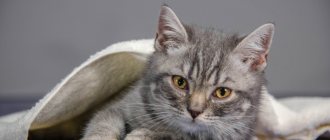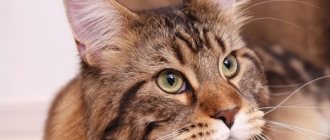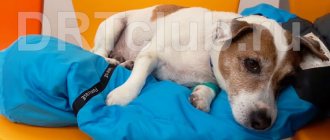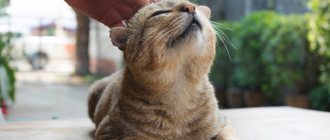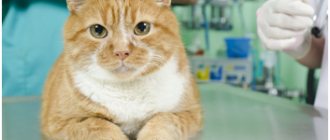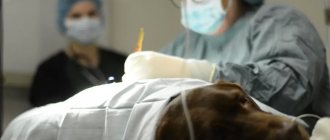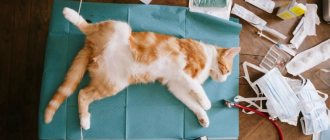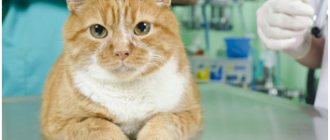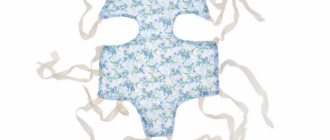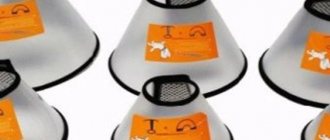Castration of animals is a simple surgical operation that involves removing the gonads in males and stopping reproductive functions. The operation is performed in a veterinary clinic or at home under general or combined anesthesia. If all rules are followed, animals do not experience any serious complications after castration. Moreover, the duration of the postoperative period largely depends on the correct actions of the owners. After the procedure, you need to pay attention not only to the health of the fluffy, but also to monitor the condition of the postoperative area. If a cat licks himself after castration and does it furiously and intensely, sutures may come apart. Bacteria can enter the wound, causing suppuration and causing acute inflammation.
What you need to know about castration
Castration is a simple and quick operation that takes no more than 20-30 minutes. But as after any surgical intervention, in order for the postoperative recovery period to pass without complications, the cat needs careful, delicate care and care.
Important! Any operation is a strong stress for the animal’s body, which can affect the condition and behavior of the pet.
If the operation went well, after about 30-40 minutes you will be able to take your pet home. Take care of a carrier, a basket, at the bottom of which place a disposable sterile diaper, clean flannel, or any other waterproof fabric. It is better to transport your cat not in public transport, as this can cause additional stress, but in a taxi or personal car.
Development of purulent inflammation
Most often, owners of operated animals contact the clinic only when the entire surgical area is swollen, inflamed, and purulent exudate flows profusely from the scrotal cavity. By the way, often licking a post-operative wound is not a “whim” of the cat himself. This happens when a pet is in pain and he tries to cope with the pain reaction in ways available to him.
In cases where your recently neutered cat cannot live without constantly licking the wound, it makes sense to take him to the vet: perhaps your pet does not need a surgical collar, but a course of antibiotics (or even additional surgery).
You should urgently call a specialist in cases where blood is constantly leaking from the scrotum in large volumes. Sometimes this indicates poor-quality ligature placement or other postoperative complications.
In most cases, signs of purulent inflammation become obvious a few hours or a couple of days after surgery. The worst thing is when the cat’s drool (along with hair and other debris) gets into the remote, closed “pockets” of the scrotal bag. In this case, inflammatory processes develop there. In the absence of air and 100% humidity, the pyogenic microflora feels ideal, which is why huge (often multiple) abscesses develop in the scrotum and adjacent tissues.
There are many cases where such abscesses, suddenly bursting, became the cause of the death of an animal from diffuse peritonitis.
Is it possible to lick a wound?
Despite the fact that the saliva of our little brothers contains enzymes and substances that accelerate healing and tissue regeneration, it can also contain pathogenic microorganisms that will lead to the development of acute inflammation, suppuration, and infection. If a cat licks a wound, the natural healing process is disrupted.
In addition, the rough tongue of felines, especially with frequent intensive licking, can lead to sutures coming apart and bleeding. If a cat licks itself, treatment with antiseptics and disinfectants will not give the desired result and will increase the rehabilitation period. Therefore, you need to constantly monitor the cat and monitor the condition of the wounds daily.
Inspect the scrotum for signs such as redness, tenderness, and swelling. If blood oozes from the wound, severe bleeding has developed, the stitches have come apart, or greenish-yellow exudate is released, immediately contact your veterinarian and take your pet to the clinic. Make sure that no dirt gets into the wounds. If, for example, the postoperative area is contaminated with feces, clean the wound with warm water and a weakly concentrated solution of betadine. Dry the seam and lubricate it with antibacterial ointment.
Important! After surgery, consult with your surgeon regarding proper care.
If, in addition to licking, the cat shows restlessness, rushes around the apartment, tries to hide in dark secluded places, constantly meows pitifully and this behavior lasts more than two days, consult a veterinarian. It’s better to play it safe once again than to correct serious consequences later.
Memo to the cat owner for 7 days
Owners whose cats have undergone castration should follow simple rules for the next 7-10 days. Which will allow you to undergo rehabilitation without problems.
Limit your time outside
Even if the cat feels good after castration, runs around the apartment and plays actively, you should not let him outside. Climbing trees and running into other cats can cause infection. In addition, it is necessary to protect your pet from intense stress. Yes, a cat can be capricious and ask to go for a walk, but you can’t follow the lead. It is important to explain the rehabilitation rules to all household members so that actions are coordinated and the animal remains safe.
Don't wash your cat right away
For a week after castration, refrain from bathing the animal, even if the cat has wet itself. Until the tissues are completely healed, water can become a conduit for infection and cause an abscess. Be patient. As soon as the stitches are removed and the wound at the incision site has healed well (to say the least), you can wash the cat with peace of mind.
What consequences should you be wary of?
The problem of urolithiasis comes first. Normally, a cat leaves territorial marks, and urine does not stagnate in the bladder. Now the cat will defecate much less frequently, which means the salts have time to form crystals and form deposits in the cavities and ducts of the urinary system.
The first thing the owner must do is to remove from the pet’s diet foods that contribute to the formation of stones (fish, dairy products), and under no circumstances give spicy, salty or fatty foods.
The second is accessible drinking. Cats are not big drinkers, but a lack of access to water will greatly aggravate the situation. Clean the litter box often. Animals may refuse to relieve themselves again if the litter box is not cleaned. The cat begins to tolerate it, the urine stagnates, crystallization and inflammatory processes occur.
What to feed the cat, transition to a new diet?
After castration, a cat's metabolic rate will change. The purr will become calmer and the need for large amounts of calories will disappear. The diet should be reduced. Make it nutritious, as free as possible from ballast, which can turn into fat deposits.
Substances that help remove excess salts from the body are added to specialized feeds. The food is easier to digest and still provides enough energy for play.
Be sure to discuss feeding rules with your veterinarian so that they can help you calculate the daily intake based on the animal’s weight. Make your pet's nutrition complete but safe, based on the recommendations of experts or give preference to a trusted manufacturer.
It will be useful for you to know how to choose the right food for a neutered cat.
Postoperative area care
To prevent the cat from licking the wounds and gnawing on the stitches, after the cat has recovered from anesthesia, put on a protective cone (Elizabethan collar) for the pet. A similar accessory can be purchased at a veterinary clinic, pet stores, or veterinary pharmacy. If desired, you can make the collar yourself using cardboard, flexible durable plastic or thick fabric. Give preference to durable material, since the cat will try to pull it off in every possible way.
To ensure that the collar does not cause discomfort to the cat or hinder movement, it must be suitable for the pet in size.
You can also protect the postoperative area from licking by using baby diapers (for newborn babies). For convenience, cut a hole for the tail.
Reproduction
In cats and kittens, puberty occurs at the age of 6-8 months. It is at this time that they are ready to give birth. However, the age at which male cats are able to produce offspring may vary depending on the conditions of detention, breed, and nutrition. It is worth noting that puberty occurs earlier than the animal’s body is fully formed, so the first heat does not at all indicate readiness to give birth. Therefore, the best time for a cat to give birth is no earlier than 8-9 months.
Cats are polycyclic, characterized by sexual seasons and reflex ovulation. The sexual cycle is the changes that a cat's body goes through from ovulation to ovulation. Females are ready to mate only during estrus, males - at almost any period. If a cat is mated to several males, then the litter may contain kittens from different genetic fathers. At the age of approximately 10 years, animals stop hunting sexually (the manifestation of sexual reflexes).
When fertilized, the cat becomes pregnant and lasts about 60 days. Then childbirth takes place, during which 3 to 6 kittens appear. They are born without teeth, blind and deaf. The weight of a newborn kitten is no more than 70 grams. Childbirth lasts up to 5 hours, at the very beginning the cat begins to behave restlessly and makes a nest. When a kitten is born, the cat begins to lick it, bites through the membrane, removes it, and bites off the umbilical cord.
What to do if a cat licks a wound
If, nevertheless, the cat licked the wound, bleeding developed, or inflammatory swelling appeared, consult a veterinarian regarding further actions. The veterinarian will prescribe symptomatic medications for general and local treatment.
As a rule, complete healing of wounds after castration occurs on the 9-13th day . But if, nevertheless, the cat licked the wound, bleeding developed, or inflammatory swelling appeared, consult a veterinarian regarding further actions. The veterinarian will prescribe symptomatic medications for general and local treatment. Ranosan, Safroderm, Sanatol, Septogel, Levomikol, Iruksolone, and other wound-healing drugs are used. Before applying medications, the wound surface is treated with any antiseptic. In case of severe swelling, anti-inflammatory ointments, gels, and liniments with an antibacterial effect are used. If there is a suspicion of severe infection, the pet is prescribed a course of antibiotic therapy.
If you notice that your pet’s condition is worsening, or symptoms that are uncharacteristic of a healthy animal are noticeable, take the cat to a veterinary clinic or call a veterinarian at home.
How the procedure is performed
Castration is performed under anesthesia by an experienced veterinarian.
This must necessarily take place in a veterinary clinic, which has specialized equipment and medications.
The cat remains under the supervision of a specialist for a while, who will monitor what is happening to the pet, how its cardiac and respiratory systems work.
For future health, the first time after the procedure and the condition on the first day are important.
Cats are castrated under anesthesia; animals tolerate its effects in different ways. They may experience unpleasant symptoms such as nausea and dizziness. Sometimes muscle weakness is also noted, the cat moves with difficulty at first and eats poorly.
At first, this is a normal phenomenon; most cats tolerate castration without serious consequences. You should not leave your pet in the clinic for more than a day (if there are no health problems).
It is important for cats to feel at home, to feel the attentive attitude of their beloved owner. This makes the rehabilitation of his body easier.
Therapeutic measures
Constant licking of fur is not a separate disease, but a symptom of a certain pathology, so treatment is selected individually, depending on the diagnosis:
- If the cause of the symptom is diseases such as allergic reactions to food or hygiene products, local spectrum drugs are prescribed - ointments and creams that eliminate unpleasant symptoms, itching and burning. To prevent allergies from occurring again, you need to determine what exactly was the allergen, otherwise the discomfort will return again. In case of a severe allergic reaction, antihistamines are prescribed for internal use.
- Infections and inflammations on the skin of infectious origin require a course of antibiotics.
- If a fungus has been identified, antifungal medications are prescribed.
Also watch the video why cats lick themselves so often:
Scrotal swelling
The development of edema is possible for several reasons:
- penetration of dirt into the wound, which often happens when castrating unwashed pets;
- when castrating an animal in a dirty, dusty room;
- with insufficient cleaning of the scrotal cavity, when clotted blood or severed tissue remains in it;
- tissue separation due to inaccurate movement of the scalpel;
- develops when the doctor fails to comply with antiseptic rules.
The inflammatory reaction is not observed immediately, but only a day or two after the operation. At first, the exudate is serous or serous-fibrinous, but after 3-4 days the process turns into purulent inflammation. The pathology is localized at the initial stage, but later spreads to adjacent tissues, covering the entire scrotum.
The clinical picture is quite bright:
- the scrotum becomes 1.5-2 times larger;
- the number of neutrophil leukocytes increases;
- body temperature increases by 1.5-2°C;
- at high temperatures, shortness of breath and increased heart rate are observed;
- the animal is lethargic and refuses to eat;
- serous or purulent exudate from a surgical wound.
Surgical treatment is possible, consisting of opening the abscess (if there is one) or treating the wound. However, the main therapy is always medicinal - systemic antibiotics. To alleviate the pet’s condition, he can be given intravenous glucose 5%, calcium chloride, or novocaine.
Urogenital pathologies
There are the following diseases of the genitourinary organs, in which the cat intensively licks under the tail:
- cystitis;
- urolithiasis disease;
- endometritis and pyometra
Cystitis
Cystitis Inflammation of the bladder due to hypothermia, unbalanced nutrition, infection of the genitals and urinary tract.
In addition to licking, it manifests itself with the following symptoms:
- urine first turns yellow, then becomes brown and foul-smelling;
- emptying of the bladder becomes more frequent, little fluid is released;
- the cat meows pitifully;
- leaves puddles everywhere.
Treatment consists of drinking plenty of fluids, fasting, rest and comfort. The veterinarian prescribes antimicrobial, immunomodulatory, and painkillers. In acute cases, the drug Stop-cystitis is prescribed. If the disease has reached a chronic stage, the herbal medicine Cat Erwin is used to relieve complications.
Prevention consists of proper nutrition, regular vaccinations, deworming, prevention of drafts and hypothermia
Urolithiasis disease
The disease is manifested by precipitation of urinary salts and injury to the urethra and ureters. The main reason is an unbalanced diet. Neutered men suffer most often. Pets that are overweight and do not exercise much are predisposed to the disease.
Clinical symptoms resemble cystitis, however, vomiting, refusal to feed, and convulsions are added. When the lumen of the urethra is blocked by stones, anuria develops, in which urine is not excreted. Acute attacks are relieved in a clinical setting. Conservative treatment and prevention include diet therapy. Veterinary feed is used.
Endometritis and pyometra
Inflammation of the uterine mucosa occurs as a result of pathological lambing or false pregnancy. A special role in the development of the disease is played by the uncontrolled use of hormonal contraceptives to disrupt estrus and unwanted pregnancy.
If conservative treatment is untimely or unsuccessful, the cervix closes and pyometra develops, a life-threatening condition. The optimal treatment is castration.
Be sure to read:
What to do if your cat has bald spots on its fur?
